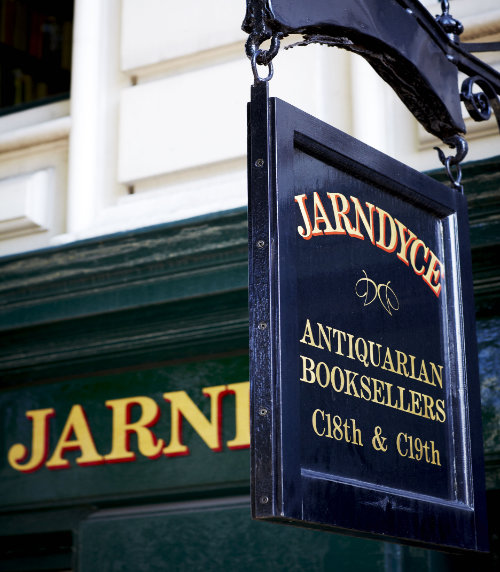ABOUT US

Jarndyce Antiquarian Booksellers, established in 1969, have published over 250 catalogues. We are the leading specialists in 17th, 18th, and particularly, 19th century English Literature & History – and we are now making forays into the 20th century.
We publish up to eight catalogues a year covering a wide variety of subjects including: Dickens, 17th & 18th Century Books & Pamphlets, Turn of the Century, The Romantics, Women Writers, 19th Century Literature, Language & Education, Economic, Social & Political History (including Philosophy), Books in Translation, Bloods & Penny Dreadfuls, Books about London, Chapbooks & Broadsides, Yellowback Novels, Plays & Theatre, and Newspapers.
Our building in Great Russell Street, opposite the British Museum, was built in c1730 and given a facelift by the Duke of Bedford in the 1850s. Randolph Caldecott, the 19th century illustrator, lived and worked here. It has been a bookshop for over 120 years and retains many period features. The ground floor has been renovated to recreate a 19th century bookshop within an 18th century building, incorporating panelling, a working fireplace and original wooden floor.
The partners are Brian Lake, Janet Nassau, and Ed Nassau Lake, assisted by Joshua Clayton, Jessica Starr, Paul Lee, Hester Malin, Sierra Herring, Malachai Darling, Philipp Dorl, and Carol Murphy.
The History of 46 Great Russell Street
No. 46 Great Russell Street was built in about 1730 as part of a development by the Duke of Bedford and stood opposite the late 17th century Montagu (or Montague) House, the site of the present British Museum.

At the time of its construction, it was on the edge of Central London; to the north there was little development. A map of Bloomsbury shows ‘Southampton Fields’ surrounding Montagu House. No. 46, like its neighbours, was built as a private house; change of the ground floor to shop use took place in the 19th century.
During 1825-1850, the new British Museum building was under construction and No. 46, along with its neighbours, was given a face-lift. The fronts were rebuilt and stuccoed to make them uniform - fitting more appropriately with the new building opposite - but the interiors remained untouched, retaining the original panelling and other features.
Randolph Caldecott (1846-1886) the illustrator, lived in rooms here between 1872-79. He had a habit of illuminating his letters with sketches incorporating the address - often showing him in a state of ease with a bottle (or two) of wine. The Randolph Caldecott Medal is now awarded annually to the most distinguished American picture books for children.

No. 46 has been a bookshop since at least 1890, when the firm of Luzac & Co., founded in Holland by Jean Luzac in the early 18th century selling and publishing books about the Middle and Far East, moved to London. About 1900, the Bedford Estate sold the freehold – reputedly to pay the Duke of Bedford’s gambling debts. Luzac & Co. survived until 1986, when Jarndyce purchased the building - having started as antiquarian booksellers in 1969 with premises in James Street and Neal Street, Covent Garden. The property was in a run-down state following a period in the 1960s-70s when the whole area south of the British Museum was designated for demolition to create space for the proposed new British Library. This plan was abandoned in 1974.
A programme of renovation for No. 46 began with the first floor, followed by re-roofing the back extension (coinciding with the renovation of the old milk depot to the rear as a studio for the painter Howard Hodgkin). The shop followed, with repair & replacement of panelling, shelving and the fireplace to recreate a 19th century bookshop in which to sell 18th and 19th century books. The next phase was renovation of the 2nd and 3rd floors; the 2nd floor retains all its panelling behind the bookshelves.
No. 46 is reputed to be haunted; one sighting was of a Scotsman in a kilt, reading a book; others have felt a presence in the basement. If there is any supernatural presence in the building, it is certainly a benevolent one.
